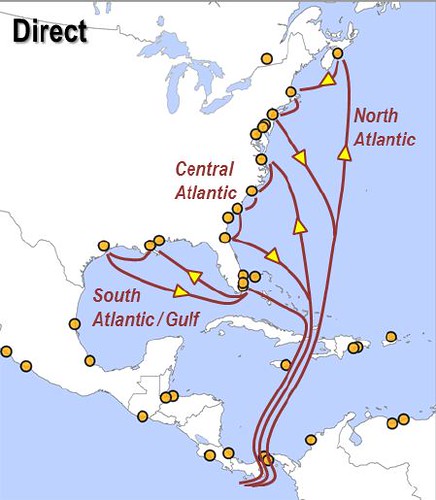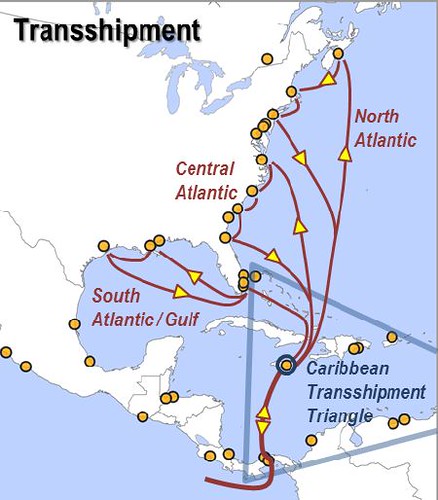One
of the proposed models is the transhipment or hub and spoke system which
consists in the transfer of goods from the origin to the destination using a
hub or intermediate point where the cargo pauses and it is handled. However,
traditional maritime economists, port and shipping lines have considered
container transhipment to be more expensive than direct call services, mainly
by virtue of the extra feeder costs and container lift charges involved.
Notwithstanding, increase in ship size has affected the decisions as to whether
direct call multiport or hub and spoke services schedules assigned due to the
technical requirement of new bigger ships.
According
to the lecture transhipment can offer substantial operating and capital cost
advantages compared with multiport direct call services: the explanation for
transhipment advantages relates to diseconomies both at sea and in port
associated with multiport styles itineraries, coupled with container handling
costs and productivity advantages pertaining to pure transhipment terminals
added to enhance feeder ships economies of scale.
One
reason for increased interest in hub and spoke networks is the trend towards
bigger ships. The major world trades are now dominated by post panamax ships of
4,000 – 6,000 TEU and above. Due to the Panama Canal Expansion project panamax
vessels will pass through the canal impacting the global freight distribution.
While
East Asia has been a driver for global economic growth for decades, it is the
Chinese economy that has the most deeply impacted the global structure for
production and trade. Therefore, US East Coast ports see the expansion of the
Panama Canal as an opportunity to increase cargo volume and gather a greater
share of the transpacific trade, which was the dominant growth factor in
containerized transportation.
In
terms of network configuration, it is a hard decisions for the maritime
shipping companies and terminals operators the impact of the Panama Canal. In
the Asia-US East Coast route several configurations are possible, ranging from
direct point to point calls from Pacific Asia to the usage of transhipment hubs
in the Caribbean. According to Rodrigue (2010) in his study “Factors Impacting North American Freight
Distribution in view of the Panama Canal Expansion” suggests potential
shipping configuration of all-water routes serving the East Coast, post Panama
Canal Expansion.
The figure 1 shows two
network configurations. In the Direct
route the East Coast can be served by three or more different direct services,
each focusing on a specific sub range as the North Atlantic, Central Atlantic
and South Atlantic / Gulf coast. In the Transhipment
route is very similar to Direct route but with the insertion of a transhipment
hub where deviation from major shipping lanes is reduced. The regional services
become feeder loops with smaller ships but higher frequencies. When the
transhipment hub offers a strategic location that significantly reduces
mainline vessel deviation time and costs and the small number of routes lead to
more efficient transportation use of resources, there is no penalty for
vessels. Therefore, the transhipment option is better than the direct call to
serve US East Coast because of the connectivity and the feeder routes
established.


Figure
1. Two network configurations; Direct and Transhipment.
The figure 1 shows two
network configurations. In the Direct
route the East Coast can be served by three or more different direct services,
each focusing on a specific sub range as the North Atlantic, Central Atlantic
and South Atlantic / Gulf coast. In the Transhipment
route is very similar to Direct route but with the insertion of a transhipment
hub where deviation from major shipping lanes is reduced. The regional services
become feeder loops with smaller ships but higher frequencies. When the
transhipment hub offers a strategic location that significantly reduces
mainline vessel deviation time and costs and the small number of routes lead to
more efficient transportation use of resources, there is no penalty for
vessels. Therefore, the transhipment option is better than the direct call to
serve US East Coast because of the connectivity and the feeder routes
established.
No hay comentarios:
Publicar un comentario